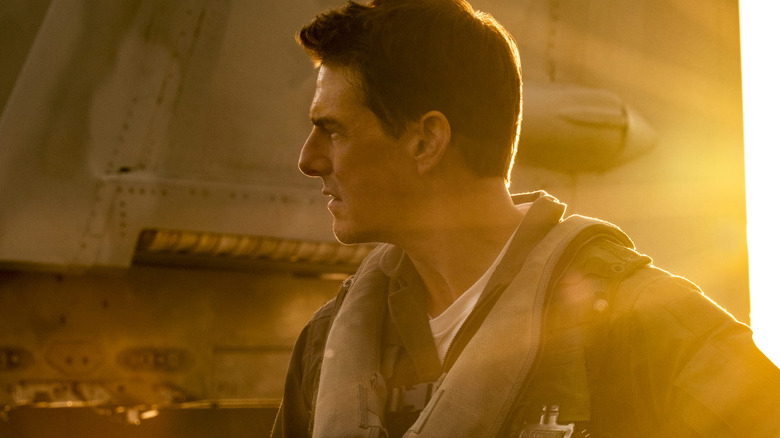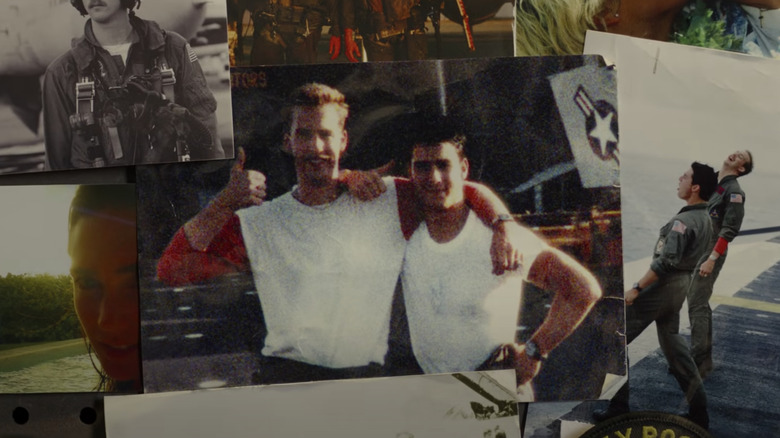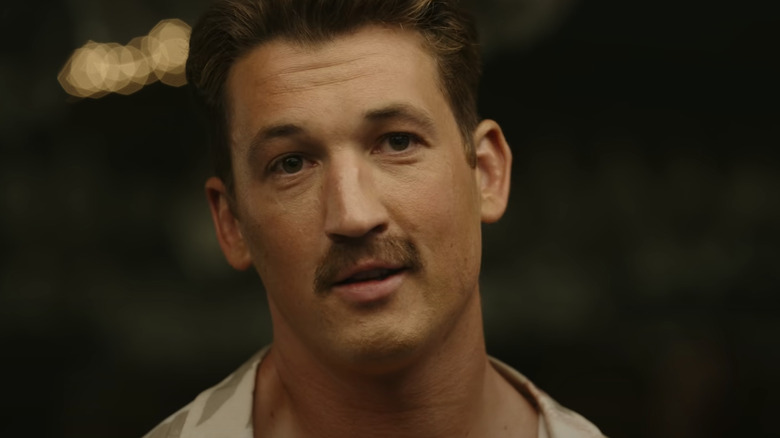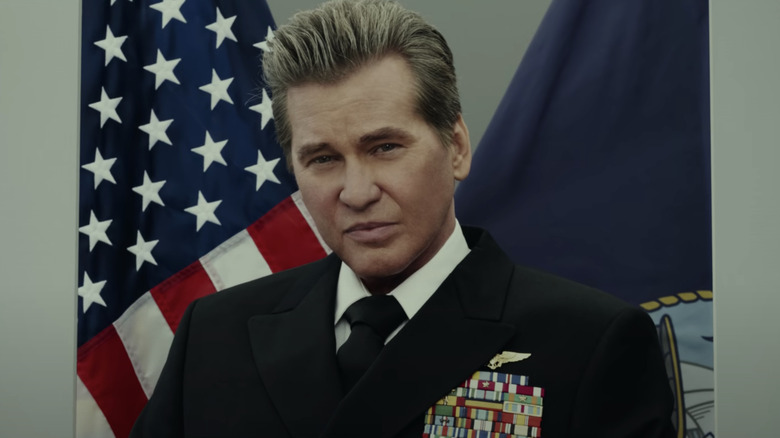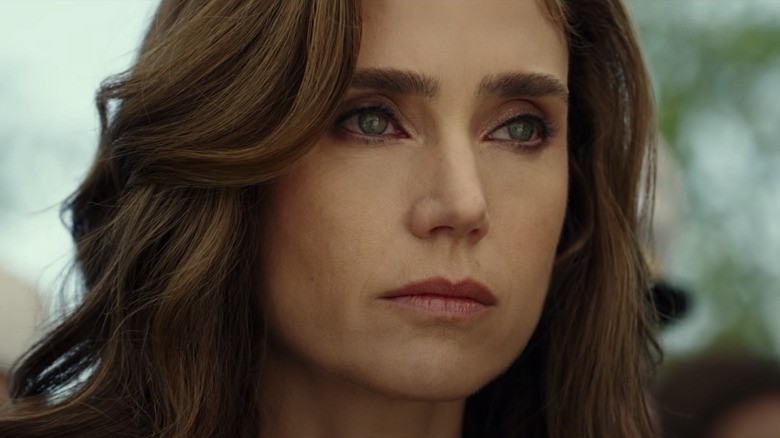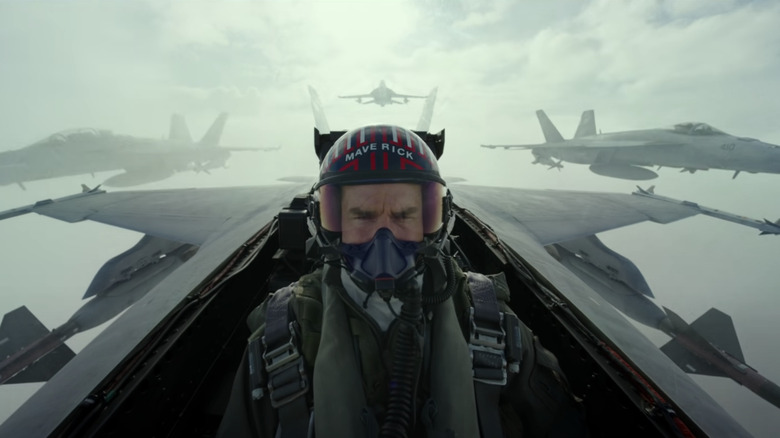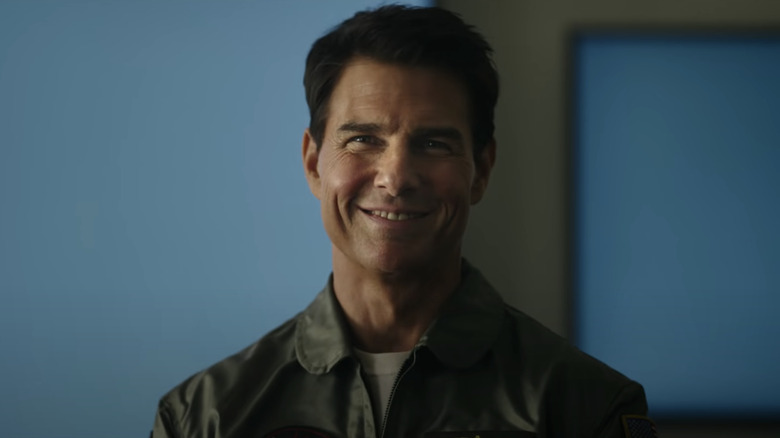Top Gun: Maverick Spoiler Review: Tom Cruise Flies The Legacy Sequel Route
This review contains spoilers for "Top Gun: Maverick."
As it ushers in the summer movie season post-Memorial Day weekend, "Top Gun: Maverick" doesn't break a lot of new ground for blockbusters, but that's not really its mission. This is a legacy sequel, here to entertain, hit familiar beats (even some from outside the franchise), and repackage the film that made Tom Cruise a global superstar for a new generation of moviegoers who are starved for human stories without superhero capes. Simultaneously, it's tasked with appeasing old-school fans who grew up with "Top Gun" and have aged along with Cruise and his titular pilot, Pete "Maverick" Mitchell.
The extent to which "Top Gun: Maverick" feels familiar may depend on how recently you've watched the original 1986 film, or how well you remember it and other tentpoles of yore like "Star Wars: A New Hope." The movie starts out with the same music and what seems like the same intro text as the original "Top Gun," though that colon leading into the title lands a touch more awkwardly here, as if the Navy were now calling its Fighter Weapons School "Top Gun: Maverick."
A flight deck crew scrambles to prep jets for takeoff and landing aboard an aircraft carrier, and we're right back in the "Danger Zone," or maybe just the audience's comfort zone. That's not necessarily a bad thing. "Top Gun: Maverick" is dedicated to the memory of Tony Scott, the director of the first "Top Gun," who died in 2012. Scott's film, too, was nothing if not a commercial package — equal parts music video, Navy recruitment video, and magic-hour ad for the 1980s.
"Top Gun: Maverick" inhabits the blockbuster landscape that the original movie helped build. Directed by Joseph Kosinski, who previously teamed with Cruise on "Oblivion," this movie never feels like it's on autopilot (or Cruise control). It's just that it's flying hotshot maneuvers within set parameters.
The love of Maverick's life
In the original "Top Gun," every character lived in service of Maverick and his homoerotic hero's journey (something Quentin Tarantino famously riffed on in his "Sleep with Me" cameo). Even his best friend's wife, Carole Bradshaw, played by Meg Ryan, was there just to comfort Maverick and give him a little pep talk after her husband died, as though she'd been written with no inner life of her own.
As much as the movie insisted on Maverick's heterosexuality, using songs like "Take My Breath Away" to sell his relationship with the androgynously named — and sometimes dressed — Charlie Blackwood (Kelly McGillis), the real love of Maverick's life was always his wingman Goose (Anthony Edwards). This is only further borne out by "Top Gun: Maverick," where Cruise's character is still struggling to let go of Goose, despite having symbolically done that already in the first movie by regaining his confidence as a pilot and throwing Goose's dog tags into the ocean.
When we first catch up with Maverick in the sequel, he's a test pilot operating out of a hangar in the Mojave Desert, and he's got photos of Goose all over the place. Charlie, meanwhile, is out of the picture and never once mentioned. "Top Gun: Maverick" also reveals in dialogue that Carole died, leaving her mustachioed son Bradley "Rooster" Bradshaw (Miles Teller) in need of a surrogate parent — though he resents Maverick for pulling his papers from the naval academy (at Carole's request) and taking years off his career.
Maverick's prototype hypersonic jet program is about to be scrapped in favor of drones by Admiral Cain (Ed Harris), which leads Captain Mitchell to take a jet up and push it past Mach 10 in a bid to save the program. He, not the DC superhero Flash, is "the fastest man alive." After crashing, he's reassigned to be an instructor in the Top Gun school thanks to the behind-the-scenes intervention of his old pal Iceman (Val Kilmer).
Mix-and-match birds and men
Maverick still texts with "Ice," and he himself endures as a plastic cipher and male fantasy with an admittedly winning smile: more the idea of a character or an extension of Cruise's screen persona than a vivid personality in his own right. He has the same haircut and the same tendency to ignore orders and do things his own way as Ethan Hunt. It's probably no coincidence that the first trailer for "Mission: Impossible – Dead Reckoning Part One" was released this past week, so that it can play in front of "Top Gun: Maverick."
Hunt has his Impossible Missions Force; Maverick has his pool of Top Gun graduates, avatars of American exceptionalism who self-identify as "the best." The two team leaders and action heroes are a bit interchangeable compared to some of the more daring roles Cruise once took on, such as Lestat in "Interview with the Vampire," Frank T.J. Mackey in "Magnolia," or Vincent in "Collateral." Contrast this with Lewis Pullman, and how different his bespectacled mission candidate (call sign: "Bob") looks from his cowboy character in "Outer Range."
It's when Maverick shows up at a bar owned by his old offscreen flame, Penny (Jennifer Connelly), that "Top Gun: Maverick" most feels like it's doing a paint-by-numbers remix of the first movie. Rooster subs for his bird-named father, Goose, while Hangman (Glen Powell), jokingly referred to as Bagman, equals Iceman.
Teller has graduated from the drums of "Whiplash" to the bar piano, on which he plays "Great Balls of Fire," the same song Goose used to play. You half-expect the film to lean on archival footage from "Top Gun," and sure enough, it goes right there and does that. During their bar encounter, Hangman calls Maverick "old-timer" and "pops," which leaves him in the same uncomfortable position that Maverick was in with Charlie at school the next day when he realizes this person is his instructor.
The Iceman cometh
In "Top Gun: Maverick," there's talk of holding onto relics and time being the greatest enemy. "The future is coming, and you're not in it," Admiral Cain tells Maverick, as if warning the audience of its mortality and Paramount Pictures on behalf of the Paramount+ streaming service. Maverick is also told his kind is "headed for extinction," and when we see Kilmer, his voice lost to real-life cancer, juxtaposed with his young matinée-idol self, it serves as a reminder that human frailty overcomes all of us, even famous actors.
Watching an old movie made with actors who are still alive can bring the same wistful effect as looking through an old photo album. More than once, "Top Gun: Maverick" lingers on a black-and-white still of Iceman and Maverick from the first film. The present Iceman, who only appears in one scene, communicates more by typing, though he does get to speak a few lines and share a hug with Maverick before his character's offscreen death.
Iceman's demise lacks the immediate narrative impact of Goose's, landing instead more like an unnecessary ploy to leverage attachment to Kilmer and previous investment in his character toward a similar emotional beat. However, it's nice that they brought Kilmer back and gave him some sort of send-off, and for Maverick's story, Iceman is instrumental in hammering home the message that he needs to let go of Goose (again) and embrace his role as someone who can lead the next generation of pilots by example.
Iceman serves as a character foil for Maverick as well, since he's risen through the ranks to become the commander of the Pacific fleet, while Maverick has never made it past captain and has "no wife, no kids, nobody to mourn him." By the end, however, we'll see that Maverick has a chance at a future with some loved ones of his own, including Rooster, Penny, and her daughter Amelia (Lyliana Wray).
Two consecutive miracles
When Amelia catches Maverick climbing down from Penny's window, it's a humorous moment, and there are other bits of comic relief like that in "Top Gun: Maverick," such as when Cruise's crash-landed character wanders into a diner and a kid mistakes him for a spaceman. Maverick's team of F-18 pilots is also young, and he has to get them working together. There's no better way to do that than team sports. This time, instead of beach volleyball, he and his fellow aviators play a shirtless football game. At one point, Maverick is left literally sitting on the sidelines in a beach chair, but it won't be long before he assumes the role of field combatant.
"Top Gun: Maverick" is co-written by Christopher McQuarrie, who took the reins of the "Mission: Impossible" franchise with "Rogue Nation," and coincidentally, it sees Maverick's team training for a seemingly impossible mission to take out a uranium enrichment site in an unnamed "rogue state." This requires flying low the ground and firing two consecutive miracle shots, which is what the franchise itself is gunning for as it upholds its pattern of having an ambiguous enemy. Maverick has to show the team that the mission is, in fact, possible, but he can only do it by once again disobeying direct orders after Admiral Beau (Jon Hamm) relieves him of his instructor post.
Prior to that, Maverick walks us through what's going to happen in the mission like a heist movie, and then it all happens with relative ease — though of course, not everything goes according to plan. Soon, Maverick and Rooster wind up behind enemy lines in a rare ground-based action scene.
"Top Gun: Maverick" excels most when it's airborne, sending up the flares in spectacular dogfight sequences, with six cameras per cockpit. Maverick flies upside down over other jets, as is his wont, and in the cockpit, he talks to Goose like the ghost of Obi-Wan Kenobi.
Star Wars on Earth
"Top Gun" was originally inspired by an image that made producer Jerry Bruckheimer think of "Star Wars on Earth." It might be described as a Hollywood "lie told with style." Like certain Marvel movies, it was made with the U.S. military's cooperation and script input. At the time, President Ronald Reagan's Star Wars program, a proposed space-based nuclear deterrent, was in development.
Skywalker Sound handled the post-production sound services for "Top Gun: Maverick," and that idea of "Star Wars on Earth" becomes more pronounced in the film's pulse-pounding climax, where it soars in terms of thrills while unabashedly drawing from one of the most well-known popcorn flicks of all time. Memorial Day weekend used to be the province of "Star Wars" movies, but now that franchise has pivoted to the small screen, with the series "Obi-Wan Kenobi" hitting Disney+ the day "Top Gun: Maverick" flew into theaters. Everything in "Top Gun: Maverick" leads up to that assault on the uranium plant, which is basically the Death Star, complete with cannons, though the terrain is more akin to Starkiller Base in "The Force Awakens."
Maverick's team carries out its own trench run in the narrow canyon leading up to their target, an exposed ventilation hatch (instead of an exhaust port), where they need to sink a bullseye less than three meters wide. The anonymous 5th Gen fighters in black helmets who try to shoot them down might as well be TIE Fighter pilots. One of them succeeds in downing Maverick, which allows Cruise to get in some of his characteristic running through a snowy forest before Maverick and Rooster sneak onto the enemy's airfield and steal an old F-14, with the movie asking self-reflexively, "How are we going to get this museum piece in the air?"
Just when it seems like all hope is lost in this bucket of bolts, the roguish Hangman flies to the rescue à la Han Solo. Maverick does a final flyby, and former rivals Rooster and Hangman shake hands like Maverick and Iceman once did amid cheers and celebration.
Barbecue blockbuster
At a certain point, it becomes reductive to just keep pointing out how similar "Top Gun: Maverick" is to other movies. "This is the same as that" can be an argument as tired as any derivative tentpole. To its credit, Kosinski's film is subtler than some legacy sequels in that it avoids having Cruise utter the same ker-ching lines like, "I feel the need ... the need for speed." Instead, it opts for its own in-movie callbacks like, "Don't think, just do," and, "It's not the plane, it's the pilot."
Everyone in the cast acquits themselves well enough, but after 36 years and numerous release delays, this long-awaited "Top Gun" follow-up only goes to show that the true pop culture icon isn't Maverick; it's Cruise. And despite his well-publicized proclivity for doing his own stunts, it feels like he's settled into a safe action-franchise groove late in his career, where he's playing the same character in every film now. Maybe that's an unfair criticism, because that's what any big movie star does.
In its defense, "Top Gun: Maverick" does consistently raise the dramatic stakes, putting Maverick in a position where he has to "fly for Top Gun or never again," and moving the team's already-impossible mission up a week. The fate of other franchise heroes such as Iron Man and James Bond in recent years has made it so that there's some genuine suspense now, too, when a legacy character like Maverick has his life on the line in the third act, since he could very well receive a noble death as a way of sealing off his story.
In the final analysis, "Top Gun: Maverick" isn't a life-changing cinematic experience, but it provides a welcome diversion for two hours, and who knows, maybe it will inspire some would-be Maverick to join the Navy. Let's just hope they end up on an aircraft carrier with better working conditions than the USS George Washington. This is a film that raids the studio pantry for familiar ingredients, firing up its afterburners for a homogenous yet enjoyable meal of barbecue blockbuster.
